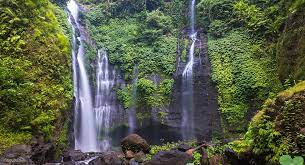
Tigawasa village of Singaraja with directions to the west a distance of ± 19 km up in Labuan Aji (Ramayana). From Labuan Aji (Ramayana) to the south with a range of ± 5 km, while the location of the village Tigawasa on sloping land in the mountains, the sea level ± 500 s / d 700 m. Tigawasa village has an area of 1690 Ha from the mountains to the beach (sea) Tukad Midget (now village Kaliasem) Bake Bunut village, Bingin Banjah and Kampung Labuan Aji is Tigawasa Village area. In the past when it was still under Dutch colonial rule, the villages mentioned above were all ruled by Perbekel Tigawasa village. Therefore those villagers who have land of rice fields, gardens, fields in the Village area Tigawasa hit three there (sarining year) each year in the form of money or rice, which is used as cash temple, and three there paddy stored in jineng Sanghiyang ( barn) in the Pura Desa. But since Indonesia’s independence and Tigawasa Village area is divided into 5 (five): 1. Tigawasa; 2. Tukad Midget (Kaliasem); 3. Bake Bunut, 4. Labuan Aji, 5. Bingin Banjah, it’s all under the District (the District) Banjar Buleleng. Since it is no longer they held three there, but if there saba (works) in Pura Pura Segara or Pawulungan, they were also maturan punia to the temple. The origins of the village Tigawasa can not be known, is still under investigation, but the real village Tigawasa is entered the village Purba (Bali Aga) because it contains a lot of archeology. According Linguistics, name of the village was made up of a compound that is a three-wasa (adult-Kawi language) means Banjar or village. So real village Tigawasa occur than 3 (three) Banjar: Banjar Sanda, banjar Pangus, Banjar Kuum Mungggah (Gunung sari). Proved there were found relics of humans in ancient times at all three sites, namely: in Banjar Sanda (Wani) Banjar Pangus and Mount Sar according to estimates of the villagers Tigawasa, since antiquity (Mulethicum) had no human lived there evidence that the there are some stone ax smooth in some places there. There is black gray and white. Village Community Tigawasa named gigin luster, considered auspicious stone. If there is contact with a pest of rice and gigin luster is soaked with water, then the water was brought to gaga basuhannya or to the fields in percikkannya in plants. Thanks to the confidence of rice diseases bias is lost, because the stone is sacred. Maybe before that there have been human beings there are in the New Stone Age (Misilithicum) because there is somewhere a huge hole (now buried) said it was a giant hole, until now around the place was called Songsasa (Song Giant) giant hole. After the Stone Age came at the bronze age (Megalithicum) This can be proved there are few relics of antiquity three places, namely: Mount sari (The munggah) in Pangus, in Wani (Suda). In wani found by the Bureau of Archaeological coffin (Sarkopah) of solid rock three (3) pieces containing human bones, rings, bracelets bronze, sepiral, beads, iron spear and a small pot. Dibanjar Wani also has twelve (12) pieces of rock in the river manger dapet fruit, in that era where people dyeing yarn or fabric with latex gintungan or over the counter. At that time people are clever ngantih or make yarn from cotton. Banjar Pangus there are four (4) pieces of the manger of rocks and still contain colored water, west banjar Pangus in Pura Sanghiyang found selending are several pairs gambelan bronze stored in Pura Pamulungan (Beagung) as sacred objects where found selending these, named the selending also dibanjar Pangus called by the name of rumbling ever found a dagger and yellow iron, also in the southeast banjar Pangus called Pememan there are four (4) pieces of joints and tumpuka rock is a menhir, and also there is a white ground in there were scratches writing or illustration. To the east of Mount Forest pememan is cider, here there are also so-called taulan Yoni Linga Linga Yoni symbol indicates Predana-Purusa in siwaisme flow. Next hick munduk taulan there are four (4) pieces of crates (Sarkopah) contain bones or human ashes, sepiral, Ketis, rings, bracelets, beads. There is also a manger where wadak (cow boar) drinking and there is also a dispersed ceramic and an Arya pandits were grana sika or adored. According to information from the department archaeological conduct an investigation and dismantling sarkopah it is said the objects sedah 2,000 years more, in sarkopah it was a common sight metal, bronze, iron, gold, copper manic-beads and other manuk culture Dengsen derived from Indochina (China) spread in Indonesia. According to the history of the ancestors of Indonesia Bangas comes from the mountains of Yemen in India behind South China turning up in Indonesia spread in the Indonesian archipelago, a group to the island of Bali.



